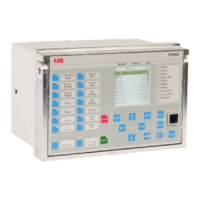1MAC309294-MB F Section 7
Measurement functions
RER620 391
Technical Manual
(Equation 49)
(Equation 50)
(Equation 51)
The phase-sequence voltage components are calculated from the phase-to-ground voltages
when VT connection is selected as “Wye” with the formulae:
(Equation 52)
(Equation 53)
(Equation 54)
When VT connection is selected as “Delta”, the positive and negative phase sequence
voltage components are calculated from the phase-to-phase voltages according to the
formulae:
(Equation 55)
(Equation 56)
7.1.3 Measurement function applications
The measurement functions are used for power system measurement, supervision and
reporting to LHMI, a monitoring tool within PCM600, or to the station level, for example,
with IEC 61850. The possibility to continuously monitor the measured values of active
power, reactive power, currents, voltages, power factors and so on, is vital for efficient
production, transmission, and distribution of electrical energy. It provides a fast and easy
overview of the present status of the power system to the system operator. Additionally, it
can be used during testing and commissioning of protection and control relays to verify the
proper operation and connection of instrument transformers, that is, the current
transformers (CTs) and voltage transformers (VTs). The proper operation of the relay
analog measurement chain can be verified during normal service by a periodic comparison
of the measured value from the relay to other independent meters.
When the zero signal is measured, the noise in the input signal can still produce small
measurement values. The zero point clamping function can be used to ignore the noise in
the input signal and, hence, prevent the noise to be shown in the user display. The zero
clamping is done for the measured analog signals and angle values.
The demand values are used to neglect sudden changes in the measured analog signals
when monitoring long time values for the input signal. The demand values are linear
average values of the measured signal over a settable demand interval. The demand values
are calculated for the measured analog three-phase current signals.

